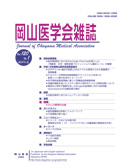

Journal of Okayama Medical Association
Published by Okayama Medical Association<Availability>
Full-text articles are available 3 years after publication.
Permalink : http://escholarship.lib.okayama-u.ac.jp/17342
Studies on endoscopic retrograde cholangiograms Part IIIStudies on cholangiograms in cases with malignant tumors of the biliary tract, pancreas and duodenum
Kikuchi, Takeshi
Published Date
1975-04-30
Abstract
Following conclusions were obtained on the basis of studies on endoscopic retrograde cholangiograms in 56 cases with malignant tumors of the biliary tract, pancreas and duodenum. 1) The rate of success of a retrograde cholangiography was high in cases with cancers of the intrahepatic and extrahepatic bile ducts, and was low in cases with carcinomas of the pancreatic head, duodenal papilla and ampulla of Vater. 2) Characteristic irregular stenosis or obstruction with proximal dilation was found in a case with carcinoma of the intrahepatic bile duct. 3) Carcinoma of the extrahepatic bile duct was divided into two types, i.e. papillary and infiltrative growths. The former revealed irregular stenosis and obstruction of the bile duct, or filling defect with dilatations of the proximal portion of the bile ducts, and the latter irregular stenosis of the bile ducts. 4) The cholangiogram of the patient with carcinoma of the pancreatic head revealed compression and infiltrations of the intrapancreatic common bile duct. 5) The cholangiogram of a patient with carcinoma of the duodenal papilla and ampulla was characteristic by showing an irregular filling defect at the end of the common bile duct. 6) Endoscopically, the carcinoma of the duodenal papilla and ampulla were divided into the following three types.
(ⅰ) Type Ⅰ is the malignant lesion localized at the major papilla. (ⅱ) Type Ⅱ is marked swelling found at the longitudinal fold. (ⅲ) Type Ⅲ showed the major papilla and longitudinal fold almost normal. Endoscopic pancreato-cholangiography is mandatory for types Ⅱ and Ⅲ. 7) The cytological examination of the pancreatic juice and bile is very useful to make the diagnosis of carcinomas of the extrahepatic bile duct, pancreatic head, duodenal papilla and ampulla, whereas the method was not so efficient in carcinomas of the intrahepatic bile buct and of the body and tail of the pancreas. Biopsy is also helpful to make the diagnosis of malignant tumors of the duodenum and carcinoma of the duodenal papilla and ampulla.
ISSN
0030-1558
NCID
AN00032489
